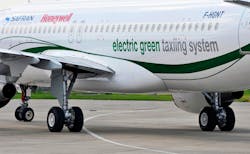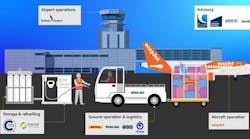PARIS, June 16, 2013 /PRNewswire/ -- Honeywell (NYSE: HON) and Safran (NYSE Euronext Paris: SAF) have completed the first major phase of testing of their electric green taxiing system (EGTS), and will make the first public demonstration of the technology, installed on an Airbus A320 aircraft, during the 50th International Paris Air Show held at Le Bourget Airport from June 17-23, 2013.
Developed by EGTS International, a joint venture between Honeywell and Safran launched in 2011, the EGTS technology enables aircraft to avoid using their main engines during taxiing and instead taxi autonomously under their own electrical power. Similar to a hybrid car using electrical power at slow speeds, EGTS will improve airline operating efficiency during taxi operations and cut fuel consumption by up to four percent per flight cycle.
EGTS will also provide environmental benefits by reducing noise and carbon and nitrogen oxide (NOx) emissions during taxi operations, and will reduce gate and tarmac congestion, improve on-time departure, and allow passengers to deplane faster as a result of smoother ground handling operations. EGTS continues to gain strong interest from airports and airlines ahead of its expected introduction to the market in 2016.
Because an aircraft's main engines are optimized for flying rather than taxiing, they burn a disproportionate amount of fuel during ground operations. With a short- or medium-range aircraft spending up to 2.5 hours of its time on taxiways every day, EGTS could save approximately 600 kilograms of fuel used during taxiing from being consumed daily, according to Honeywell and Safran estimates.
EGTS allows aircraft to push back autonomously and then taxi between gate and runway without engaging the main engines by using the Auxiliary Power Unit (APU) generator to power electric motors in the main landing gear. Each of an EGTS-equipped aircraft's powered wheels is fitted with a control system, giving pilots total control of the aircraft's speed and direction during taxi operations. In addition to reduced fuel burn, the system will also generate further savings by reducing engine and brake wear and minimizing the risk of damage to engine turbines from foreign objects on the tarmac.
The initial development of EGTS to date has mobilized more than 200 engineers working in 13 Safran and Honeywell facilities around the world. The component system and aircraft testing program has accumulated more than 3,000 hours of testing on seven bespoke testing benches and rigs, including on-ground maneuvers in Toulouse, France, on an A320 modified by the joint venture for the EGTS development program.
Since this aircraft's "first move" in April of this year, the EGTS fitted to it has logged close to 160 kilometers (100 miles) of rolling tests. These tests evaluate the system in various load configurations and runway conditions, through a series of complex maneuvers such as pushback, tight turns and U-turns, according to varying specifications of acceleration and speed. The next major milestone of the testing program following the Paris Air Show will be to conduct these same maneuvers at speeds up to 20 knots, at full performance and with the aircraft at maximum take-off weight (MTOW).
Supporting Quotes
Brian Wenig, EGTS Program Vice President, Honeywell Aerospace
"EGTS will be for aviation what hybrid cars were for the automotive industry. The potential of fuel savings and emissions reductions that can be had with the system will be monumental for airlines, delivered by two leaders in their respective fields."
Olivier Savin, EGTS Program Vice President, Safran
"We are extremely pleased to showcase these demonstrations at the Paris Air Show, proving the credibility of our partnership and solution. Safran and Honeywell are highly engaged in the development of electrical technologies for aircraft that will help the industry revolutionize the way it conducts taxiing operations in the future. EGTS clearly demonstrates the multiple benefits gained from a system that combines concrete cost-savings with significant emissions reductions for the benefits of airlines, airports and ultimately passengers."
Jens Berlinson, Test Pilot, Safran
"EGTS is a revolutionary system that brings immediate benefits for a pilot operating in congested airports. In addition to faster push-back times, being fully autonomous with its reverse mode, the system is very smooth and so easy to operate, enabling the plane to accelerate without any delay, and move at a steady rate. With EGTS we no longer need to use the brakes unlike with today's aircraft that have a tendency to accelerate naturally even when the engines are at idle. This is especially valuable in busy airports, where planes are often queuing up for an extended period of time before take-off."
Supporting Resources
About Honeywell Aerospace
Learn more about EGTS International Follow @green_taxiingon Twitter
Thousands of Honeywell Aerospace products and services are found on virtually every commercial, defense and space aircraft worldwide. The Aerospace business unit develops and integrates technologies that span air traffic modernization, flight and runway safety, engines, cockpit and cabin electronics, connectivity, logistics and more that deliver safe, efficient, productive and comfortable transportation-related experiences. For more information, visit
http://aerospace.honeywell.com
or follow us at
on Twitter.
Honeywell (www.honeywell.com) is a Fortune 100 diversified technology and manufacturing leader, serving customers worldwide with aerospace products and services; control technologies for buildings, homes and industry; turbochargers; and performance materials. Based in Morris Township, N.J., Honeywell's shares are traded on the New York, London, and Chicago Stock Exchanges. For more news and information on Honeywell, please visit www.honeywellnow.com.
About Safran
Safran is a leading international high-technology group with three core businesses: Aerospace propulsion and equipment), Defence and Security. Operating worldwide, the Group has 62,500 employees and generated sales of 13.6 billion euros in 2012. Working alone or in partnership, Safran holds world or European leadership positions in its core markets. The Group invests heavily in Research & Development to meet the requirements of changing markets, including expenditures of 1.6 billion Euros in 2012. Safran is listed on NYSE Euronext Paris and is part of the CAC40 index.
For more information, www.safran-group.com / Follow @SAFRAN on Twitter
Honeywell and the Honeywell logo are the exclusive properties of Honeywell, are registered with the U.S. Patent and Trademark Office, and may be registered or pending registration in other countries. All other Honeywell product names, technology names, trademarks, service marks, and logos may be registered or pending registration in the U.S. or in other countries. All other trademarks or registered trademarks are the property of their respective owners. Copyright 2013 Honeywell.
This release contains certain statements that may be deemed "forward-looking statements" within the meaning of Section 21E of the Securities Exchange Act of 1934. All statements, other than statements of historical fact, that address activities, events or developments that we or our management intends, expects, projects, believes or anticipates will or may occur in the future are forward-looking statements. Such statements are based upon certain assumptions and assessments made by our management in light of their experience and their perception of historical trends, current economic and industry conditions, expected future developments and other factors they believe to be appropriate. The forward-looking statements included in this release are also subject to a number of material risks and uncertainties, including but not limited to economic, competitive, governmental, and technological factors affecting our operations, markets, products, services and prices. Such forward-looking statements are not guarantees of future performance, and actual results, developments and business decisions may differ from those envisaged by such forward-looking statements. We identify the principal risks and uncertainties that affect our performance in our Form 10-K and other filings with the Securities and Exchange Commission.
SOURCE Honeywell
Related Photos: Photo,




